Comparison of Polypropylene and Ceramic Microfiltration Membranes Applied for Separation of 1,3-PD Fermentation Broths and Saccharomyces cerevisiae Yeast Suspensions
Abstract
:1. Introduction
2. Materials and Methods
2.1. Feed Suspensions
2.2. Microfiltration Set-Up and Process Parameters
2.3. Analytical Methods
3. Results
3.1. Membranes Morphology and Maximum Performance
3.2. Filtration of Fermentation Broths with Citrobacer freundii Bacteria
3.3. Filtration of Fermentation Broths with Lactobacillus casei Bacteria
3.4. Filtration of Yeast Suspensions
4. Conclusions
Author Contributions
Funding
Institutional Review Board Statement
Informed Consent Statement
Conflicts of Interest
Abbreviations
| CA | cellulose acetate |
| CR | chemical cleaning (rinsing) |
| J | actual permeate flux |
| J0 | maximum permeate flux |
| MF | microfiltration |
| NTU | nephelometric turbidity units |
| PAN | polyacrylonitrile |
| PAEK | polyaryletherketone |
| PES | polyethersulfone |
| PI | polyamide |
| PP | polypropylene |
| PTT | polytrimethylene terephthalate |
| PVDF | polyvinylidenefluoride |
| PVP | polyvinylpyrrolidone |
| NF | nanofiltration |
| SEM | scanning electron microscopy |
| TMP | transmembrane pressure |
| UF | ultrafiltration |
| VF | feed flow velocity |
| 1,3-PD | 1,3-propanediol |
References
- Belfort, G.; Davis, R.H.; Zydney, A.L. The Behavior of Suspensions and Macromolecular Solutions in Crossflow Microfiltration. J. Membr. Sci. 1994, 96, 1–58. [Google Scholar] [CrossRef]
- Chew, J.W.; Kilduff, J.; Belfort, G. The Behavior of Suspensions and Macromolecular Solutions in Crossflow Microfiltration: An Update. J. Membr. Sci. 2020, 601, 117865. [Google Scholar] [CrossRef]
- Białas, W.; Celińska, E.; Dembczyński, R.; Szymanowska, D.; Nowacka, M.; Jesionowski, T.; Grajek, W. Cross-Flow Microfiltration of Fermentation Broth Containing Native Corn Starch. J. Membr. Sci. 2013, 427, 118–128. [Google Scholar] [CrossRef]
- Kujundzic, E.; Greenberg, A.R.; Fong, R.; Moore, B.; Kujundzic, D.; Hernandez, M. Biofouling Potential of Industrial Fermentation Broth Components during Microfiltration. J. Membr. Sci. 2010, 349, 44–55. [Google Scholar] [CrossRef]
- Tomczak, W.; Gryta, M. Cross-Flow Microfiltration of Glycerol Fermentation Broths with Citrobacter Freundii. Membranes 2020, 10, 67. [Google Scholar] [CrossRef] [PubMed] [Green Version]
- Thuy, N.T.H.; Boontawan, A. Production of Very-High Purity Succinic Acid from Fermentation Broth Using Microfiltration and Nanofiltration-Assisted Crystallization. J. Membr. Sci. 2017, 524, 470–481. [Google Scholar] [CrossRef]
- Gryta, M.; Tomczak, W. Microfiltration of Post-Fermentation Broth with Backflushing Membrane Cleaning. Chem. Pap. 2015, 69. [Google Scholar] [CrossRef]
- Yang, X.; Zhou, S.; Li, M.; Wang, R.; Zhao, Y. Purification of Cellulase Fermentation Broth via Low Cost Ceramic Microfiltration Membranes with Nanofibers-like Attapulgite Separation Layers. Sep. Purif. Technol. 2017, 175, 435–442. [Google Scholar] [CrossRef]
- Jokić, A.; Pajčin, I.; Grahovac, J.; Lukić, N.; Dodić, J.; Rončević, Z.; Šereš, Z. Improving Energy Efficiency of Bacillus Velezensis Broth Microfiltration in Tubular Ceramic Membrane by Air Sparging and Turbulence Promoter. J. Chem. Technol. Biotechnol. 2019. [Google Scholar] [CrossRef]
- Marzban, R.; Saberi, F.; Shirazi, M.M.A. Microfiltration and Ultrafiltration of Bacillus Thuringiensis Fermentation Broth: Membrane Performance and Sporecrystal Recovery Approach. Braz. J. Chem. Eng. 2016, 33, 783–791. [Google Scholar] [CrossRef] [Green Version]
- Sikder, J.; Pereira, C.; Palchoudhury, S.; Vohra, K.; Basumatary, D.; Pal, P. Synthesis and Characterization of Cellulose Acetate-Polysulfone Blend Microfiltration Membrane for Separation of Microbial Cells from Lactic Acid Fermentation Broth. Desalination 2009, 249, 802–808. [Google Scholar] [CrossRef]
- Carrère, H.; Blaszkow, F. Comparison of Operating Modes for Clarifying Lactic Acid Fermentation Broths by Batch Cross-Flow Microfiltration. Process Biochem. 2001, 36, 751–756. [Google Scholar] [CrossRef]
- Davies, J.L.; Baganz, F.; Ison, A.P.; Lye, G.J. Studies on the Interaction of Fermentation and Microfiltration Operations: Erythromycin Recovery From Saccharopolyspora Erythraea Fermentation Broths. Biotechnol. Bioeng. 2000, 69, 429–439. [Google Scholar] [CrossRef]
- Milcent, S.; Carrère, H. Clarification of Lactic Acid Fermentation Broths. Sep. Purif. Technol. 2001, 22–23, 393–401. [Google Scholar] [CrossRef]
- Persson, A.; Jönsson, A.-S.; Zacchi, G. Separation of Lactic Acid-Producing Bacteria from Fermentation Broth Using a Ceramic Microfiltration Membrane with Constant Permeate Flow. Biotechnol. Bioeng. 2001, 72, 269–277. [Google Scholar] [CrossRef]
- Persson, A.; Jönsson, A.-S.; Zacchi, G. Use of Microfiltration as First Step in Recovery of Protein a from Fermentation Broth. Appl. Biochem. Biotechnol. 2004, 112, 151–162. [Google Scholar] [CrossRef]
- Toussaint, G.; Ding, L.H.; Jaffrin, M.Y.; Hassairi, I.; Nonus, M. Recovery of α-Agarase Enzyme from Fermentation Broths by Membrane Crossflow Filtration. Sep. Sci. Technol. 2000, 35, 795–809. [Google Scholar] [CrossRef]
- Alexandri, M.; Schneider, R.; Venus, J. Membrane Technologies for Lactic Acid Separation from Fermentation Broths Derived from Renewable Resources. Membranes 2018, 8, 94. [Google Scholar] [CrossRef] [Green Version]
- Gençal, Y.; Durmaz, E.N.; Çulfaz-Emecen, P.Z. Preparation of Patterned Microfiltration Membranes and Their Performance in Crossflow Yeast Filtration. J. Membr. Sci. 2015, 476, 224–233. [Google Scholar] [CrossRef]
- Hassan, I.; Ennouri, M.; Lafforgue, C.; Schmitz, P.; Ayadi, A. Experimental Study of Membrane Fouling during Crossflow Microfiltration of Yeast and Bacteria Suspensions: Towards an Analysis at the Microscopic Level. Membranes 2013, 3, 44–68. [Google Scholar] [CrossRef] [Green Version]
- Jokić, A.; Zavargo, Z.; Šereš, Z.; Tekić, M. The Effect of Turbulence Promoter on Cross-Flow Microfiltration of Yeast Suspensions: A Response Surface Methodology Approach. J. Membr. Sci. 2010, 350, 269–278. [Google Scholar] [CrossRef]
- Lewis, W.J.T.; Chew, Y.M.J.; Bird, M.R. The Application of Fluid Dynamic Gauging in Characterising Cake Deposition during the Cross-Flow Microfiltration of a Yeast Suspension. J. Membr. Sci. 2012, 405–406, 113–122. [Google Scholar] [CrossRef] [Green Version]
- Liu, D.; Savoire, R.; Vorobiev, E.; Lanoisellé, J.-L. Effect of Disruption Methods on the Dead-End Microfiltration Behavior of Yeast Suspension. Sep. Sci. Technol. 2010, 45, 1042–1050. [Google Scholar] [CrossRef]
- Ogunbiyi, O.O.; Miles, N.J.; Hilal, N. The Effects of Performance and Cleaning Cycles of New Tubular Ceramic Microfiltration Membrane Fouled with a Model Yeast Suspension. Desalination 2008, 220, 273–289. [Google Scholar] [CrossRef]
- Mota, M.; Flickinger, M.C. Modeling the Influence of Slurry Concentration on Saccharomyces Cerevisiae Cake Porosity and Resistance during Microfiltration. Biotechnol. Prog. 2012, 28, 1534–1541. [Google Scholar] [CrossRef] [Green Version]
- Keskinler, B.; Yildiz, E.; Erhan, E.; Dogru, M.; Bayhan, Y.; Akay, G. Crossflow Microfiltration of Low Concentration-Nonliving Yeast Suspensions. J. Membr. Sci. 2004, 233, 59–69. [Google Scholar] [CrossRef]
- Gabrus, E.; Szaniawska, D. Application of Backflushing for Fouling Reduction during Microfiltration of Yeast Suspensions. Desalination 2009, 240, 46–53. [Google Scholar] [CrossRef]
- Stopka, J.; Bugan, S.; Broussous, L.; Schlosser, Š.; Larbot, A. Microfiltration of Beer Yeast Suspensions through Stamped Ceramic Membranes. Sep. Purif. Technol. 2001, 25, 535–543. [Google Scholar] [CrossRef]
- Mores, W.D.; Davis, R.H. Yeast Foulant Removal by Backpulses in Crossflow Microfiltration. J. Membr. Sci. 2002, 208, 389–404. [Google Scholar] [CrossRef]
- Mores, W. Direct Visual Observation of Yeast Deposition and Removal during Microfiltration. J. Membr. Sci. 2001, 189, 217–230. [Google Scholar] [CrossRef]
- Mahesh Kumar, S.; Roy, S. Filtration Characteristics in Dead-End Microfiltration of Living Saccharomyces Cerevisiae Cells by Alumina Membranes. Desalination 2008, 229, 348–361. [Google Scholar] [CrossRef]
- Keskinler, B.; Akay, G.; Bayhan, Y.; Erhan, E. Effect of Ionic Environment on the Crossflow Microfiltration Behaviour of Yeast Suspensions. J. Membr. Sci. 2002, 206, 351–360. [Google Scholar] [CrossRef]
- Coulson, J.M.; Richardson, J.F. Coulson & Richardson’s Chemical Engineering; Butterworth-Heinemann: Boston, MA, USA; ISBN 9780750644457.
- Manni, A.; Achiou, B.; Karim, A.; Harrati, A.; Sadik, C.; Ouammou, M.; Alami Younssi, S.; El Bouari, A. New Low-Cost Ceramic Microfiltration Membrane Made from Natural Magnesite for Industrial Wastewater Treatment. J. Environ. Chem. Eng. 2020, 8, 103906. [Google Scholar] [CrossRef]
- Available online: https://www.bccresearch.com/market-research/membrane-and-separation-technology/membrane-microfiltration.
- Speed, D.E. Environmental aspects of planarization processes. In Advances in chemical mechanical planarization (CMP); Elsevier: Amsterdam, The Netherlands, 2016; pp. 229–269. ISBN 978-0-08-100165-3. [Google Scholar]
- Warsinger, D.M.; Chakraborty, S.; Tow, E.W.; Plumlee, M.H.; Bellona, C.; Loutatidou, S.; Karimi, L.; Mikelonis, A.M.; Achilli, A.; Ghassemi, A.; et al. A Review of Polymeric Membranes and Processes for Potable Water Reuse. Prog. Polym. Sci. 2018, 81, 209–237. [Google Scholar] [CrossRef] [PubMed]
- Li, C.; Sun, W.; Lu, Z.; Ao, X.; Li, S. Ceramic Nanocomposite Membranes and Membrane Fouling: A Review. Water Res. 2020, 175, 115674. [Google Scholar] [CrossRef] [PubMed]
- Gaspar, I.; Koris, A.; Bertalan, Z.; Vatai, G. Comparison of Ceramic Capillary Membrane and Ceramic Tubular Membrane with Inserted Static Mixer. Chem. Pap. 2011, 65. [Google Scholar] [CrossRef]
- Kumar, C.M.; Roshni, M.; Vasanth, D. Treatment of Aqueous Bacterial Solution Using Ceramic Membrane Prepared from Cheaper Clays: A Detailed Investigation of Fouling and Cleaning. J. Water Process Eng. 2019, 29, 100797. [Google Scholar] [CrossRef]
- Hubadillah, S.K.; Othman, M.H.D.; Matsuura, T.; Ismail, A.F.; Rahman, M.A.; Harun, Z.; Jaafar, J.; Nomura, M. Fabrications and Applications of Low Cost Ceramic Membrane from Kaolin: A Comprehensive Review. Ceram. Int. 2018, 44, 4538–4560. [Google Scholar] [CrossRef]
- Baruah, G.L.; Nayak, A.; Belfort, G. Scale-up from Laboratory Microfiltration to a Ceramic Pilot Plant: Design and Performance. J. Membr. Sci. 2006, 274, 56–63. [Google Scholar] [CrossRef]
- Ghouil, B.; Harabi, A.; Bouzerara, F.; Brihi, N. Elaboration and Characterization of Ceramic Membrane Supports from Raw Materials Used in Microfiltration. Desalin. Water Treat. 2016, 57, 5241–5245. [Google Scholar] [CrossRef]
- Issaoui, M.; Limousy, L. Low-Cost Ceramic Membranes: Synthesis, Classifications, and Applications. C. R. Chim. 2019, 22, 175–187. [Google Scholar] [CrossRef]
- Muthukumaran, S.; Baskaran, K. Comparison of the Performance of Ceramic Microfiltration and Ultrafiltration Membranes in the Reclamation and Reuse of Secondary Wastewater. Desalin. Water Treat. 2014, 52, 670–677. [Google Scholar] [CrossRef] [Green Version]
- Hofs, B.; Ogier, J.; Vries, D.; Beerendonk, E.F.; Cornelissen, E.R. Comparison of Ceramic and Polymeric Membrane Permeability and Fouling Using Surface Water. Sep. Purif. Technol. 2011, 79, 365–374. [Google Scholar] [CrossRef]
- Lorente-Ayza, M.-M.; Mestre, S.; Menéndez, M.; Sánchez, E. Comparison of Extruded and Pressed Low Cost Ceramic Supports for Microfiltration Membranes. J. Eur. Ceram. Soc. 2015, 35, 3681–3691. [Google Scholar] [CrossRef]
- Tan, X.; Rodrigue, D. A Review on Porous Polymeric Membrane Preparation. Part II: Production Techniques with Polyethylene, Polydimethylsiloxane, Polypropylene, Polyimide, and Polytetrafluoroethylene. Polymers 2019, 11, 1310. [Google Scholar] [CrossRef] [Green Version]
- Staszak, K.; Karaś, Z.; Jaworska, K. Comparison of Polymeric and Ceramic Membranes Performance in the Process of Micellar Enhanced Ultrafiltration of Cadmium(II) Ions from Aqueous Solutions. Chem. Pap. 2013, 67. [Google Scholar] [CrossRef]
- Díaz-Montes, E.; Castro-Muñoz, R. Metabolites Recovery from Fermentation Broths via Pressure-driven Membrane Processes. Asia-Pac. J. Chem. Eng. 2019, 14. [Google Scholar] [CrossRef]
- Karasu, K.; Glennon, N.; Lawrence, N.D.; Stevens, G.W.; O’Connor, A.J.; Barber, A.R.; Yoshikawa, S.; Kentish, S.E. A Comparison between Ceramic and Polymeric Membrane Systems for Casein Concentrate Manufacture. Int. J. Dairy Technol. 2010, 63, 284–289. [Google Scholar] [CrossRef]
- Arkhangelsky, E.; Kuzmenko, D.; Gitis, N.V.; Vinogradov, M.; Kuiry, S.; Gitis, V. Hypochlorite Cleaning Causes Degradation of Polymer Membranes. Tribol. Lett. 2007, 28, 109–116. [Google Scholar] [CrossRef]
- Arkhangelsky, E.; Kuzmenko, D.; Gitis, V. Impact of Chemical Cleaning on Properties and Functioning of Polyethersulfone Membranes. J. Membr. Sci. 2007, 305, 176–184. [Google Scholar] [CrossRef]
- Malczewska, B.; Żak, A. Structural Changes and Operational Deterioration of the Uf Polyethersulfone (Pes) Membrane Due to Chemical Cleaning. Sci. Rep. 2019, 9. [Google Scholar] [CrossRef] [PubMed] [Green Version]
- Wang, P.; Wang, Z.; Wu, Z.; Zhou, Q.; Yang, D. Effect of Hypochlorite Cleaning on the Physiochemical Characteristics of Polyvinylidene Fluoride Membranes. Chem. Eng. J. 2010, 162, 1050–1056. [Google Scholar] [CrossRef]
- Puspitasari, V.; Granville, A.; Le-Clech, P.; Chen, V. Cleaning and Ageing Effect of Sodium Hypochlorite on Polyvinylidene Fluoride (PVDF) Membrane. Sep. Purif. Technol. 2010, 72, 301–308. [Google Scholar] [CrossRef]
- Causserand, C.; Rouaix, S.; Lafaille, J.-P.; Aimar, P. Ageing of Polysulfone Membranes in Contact with Bleach Solution: Role of Radical Oxidation and of Some Dissolved Metal Ions. Chem. Eng. Process. 2008, 47, 48–56. [Google Scholar] [CrossRef] [Green Version]
- Rouaix, S.; Causserand, C.; Aimar, P. Experimental Study of the Effects of Hypochlorite on Polysulfone Membrane Properties. J. Membr. Sci. 2006, 277, 137–147. [Google Scholar] [CrossRef] [Green Version]
- Rabuni, M.F.; Nik Sulaiman, N.M.; Aroua, M.K.; Yern Chee, C.; Awanis Hashim, N. Impact of in Situ Physical and Chemical Cleaning on PVDF Membrane Properties and Performances. Chem. Eng. Sci. 2015, 122, 426–435. [Google Scholar] [CrossRef] [Green Version]
- Park, K.; Kim, P.; Kim, H.G.; Kim, J. A Comparison of Fouling and Cleaning Properties between Ceramic and Polymeric Microfiltration Membranes for Algal Rich Water. Desalin. Water Treat. 2020, 173, 21–27. [Google Scholar] [CrossRef]
- Bodzek, M.; Konieczny, K. Comparison of Various Membrane Types and Module Configurations in the Treatment of Natural Water by Means of Low-Pressure Membrane Methods. Sep. Purif. Technol. 1998, 14, 69–78. [Google Scholar] [CrossRef]
- Sutton-Sharp, E.; Ravereau, J.; Guennec, M.; Brehant, A.; Bonnard, R. Benefits of Polymeric Membranes in Oil and Gas Produced Water Treatment. Water Pract. Technol. 2018, 13, 303–311. [Google Scholar] [CrossRef]
- Dashtban Kenari, S.L.; Barbeau, B. Understanding Ultrafiltration Fouling of Ceramic and Polymeric Membranes Caused by Oxidized Iron and Manganese in Water Treatment. J. Membr. Sci. 2016, 516, 1–12. [Google Scholar] [CrossRef]
- Lee, S.; Cho, J. Comparison of Ceramic and Polymeric Membranes for Natural Organic Matter (NOM) Removal. Desalination 2004, 160, 223–232. [Google Scholar] [CrossRef]
- Vatai, G.N.; Krstic, D.M.; Koris, A.K.; Gáspár, I.L.; Tekic, M.N. Ultrafiltration of Oil-in-Water Emulsion: Comparison of Ceramic and Polymeric Membranes. Desalination Water Treat. 2009, 3, 162–168. [Google Scholar] [CrossRef]
- Fujioka, T.; Khan, S.J.; McDonald, J.A.; Nghiem, L.D. Nanofiltration of Trace Organic Chemicals: A Comparison between Ceramic and Polymeric Membranes. Sep. Purif. Technol. 2014, 136, 258–264. [Google Scholar] [CrossRef]
- López, J.; Reig, M.; Vecino, X.; Gibert, O.; Cortina, J.L. Comparison of Acid-Resistant Ceramic and Polymeric Nanofiltration Membranes for Acid Mine Waters Treatment. Chem. Eng. J. 2020, 382, 122786. [Google Scholar] [CrossRef]
- Vivek, N.; Pandey, A.; Binod, P. Production and applications of 1,3-propanediol. In Current Developments in Biotechnology and Bioengineering; 1st ed.; Pandey, A., Larroche, C., Soccol, C.R., Eds.; Elsevier: Amsterdam, The Netherlands, 2017; pp. 719–738. ISBN 978-0-444-63662-1. [Google Scholar]
- Kim, J.M.; Lee, I.; Park, J.Y.; Hwang, K.T.; Bae, H.; Park, H.J. Applicability of Biaxially Oriented Poly(Trimethylene Terephthalate) Films Using Bio-Based 1,3-Propanediol in Retort Pouches. J. Appl. Polym. Sci. 2018, 135, 46251. [Google Scholar] [CrossRef]
- Hong, Y.K. Purification of 1,3-Propanediol for Production of Polytrimethylene ^terephthalate (PTT) from Biomass. Adv. Mat. Res. 2011, 320, 191–195. [Google Scholar] [CrossRef]
- Kluge, M.; Pérocheau Arnaud, S.; Robert, T. 1,3-Propanediol and Its Application in Bio-Based Polyesters for Resin Applications. Chem. Africa 2019, 2, 215–221. [Google Scholar] [CrossRef]
- Gryta, M.; Markowska-Szczupak, A.; Bastrzyk, J.; Tomczak, W. The Study of Membrane Distillation Used for Separation of Fermenting Glycerol Solutions. J. Membr. Sci. 2013, 431, 1–8. [Google Scholar] [CrossRef]
- Bastrzyk, J.; Gryta, M.; Karakulski, K. Fouling of Nanofiltration Membranes Used for Separation of Fermented Glycerol Solutions. Chem. Pap. 2014, 68. [Google Scholar] [CrossRef]
- Kavšček, M.; Stražar, M.; Curk, T.; Natter, K.; Petrovič, U. Yeast as a Cell Factory: Current State and Perspectives. Microb. Cell Factories 2015, 14. [Google Scholar] [CrossRef] [Green Version]
- Tomczak, W.; Gryta, M. The Application of Ultrafiltration for Separation of Glycerol Solution Fermented by Bacteria. Pol. J. Chem. Technol. 2013, 15, 115–120. [Google Scholar] [CrossRef] [Green Version]
- Gryta, M.; Waszak, M.; Tomaszewska, M. Studies of Polypropylene Membrane Fouling during Microfiltration of Broth with Citrobacter Freundii Bacteria. Pol. J. Chem. Technol. 2015, 17, 56–64. [Google Scholar] [CrossRef] [Green Version]
- Nady, N.; Franssen, M.C.R.; Zuilhof, H.; Eldin, M.S.M.; Boom, R.; Schroën, K. Modification Methods for Poly(Arylsulfone) Membranes: A Mini-Review Focusing on Surface Modification. Desalination 2011, 275, 1–9. [Google Scholar] [CrossRef]
- Wang, Z.; Ma, J.; Tang, C.Y.; Kimura, K.; Wang, Q.; Han, X. Membrane Cleaning in Membrane Bioreactors: A Review. J. Membr. Sci. 2014, 468, 276–307. [Google Scholar] [CrossRef]
- Someya, M.; Higashino, K.; Imoto, Y.; Sakanakura, H.; Yasutaka, T. Effects of Membrane Filter Material and Pore Size on Turbidity and Hazardous Element Concentrations in Soil Batch Leaching Tests. Chemosphere 2020, 128981. [Google Scholar] [CrossRef]
- Tomczak, W.; Gryta, M. Clarification of 1,3-Propanediol Fermentation Broths by Using a Ceramic Fine UF Membrane. Membranes 2020, 10, 319. [Google Scholar] [CrossRef] [PubMed]
- Silva, J.R.; Cardoso, G.; Maciel, R.R.G.; de Souza, N.C. Morphological Alterations on Citrobacter Freundii Bacteria Induced by Erythrosine Dye and Laser Light. Lasers Med. Sci. 2015, 30, 469–473. [Google Scholar] [CrossRef]
- Choi, H.; Zhang, K.; Dionysiou, D.D.; Oerther, D.B.; Sorial, G.A. Influence of Cross-Flow Velocity on Membrane Performance during Filtration of Biological Suspension. J. Membr. Sci. 2005, 248, 189–199. [Google Scholar] [CrossRef]
- Jana, A.; Ghosh, S.; Majumdar, S. Energy Efficient Harvesting of Arthrospira Sp. Using Ceramic Membranes: Analyzing the Effect of Membrane Pore Size and Incorporation of Flocculant as Fouling Control Strategy. J. Chem. Technol. Biotechnol. 2018, 93, 1085–1096. [Google Scholar] [CrossRef]
- Streit, F.; Athès, V.; Bchir, A.; Corrieu, G.; Béal, C. Microfiltration Conditions Modify Lactobacillus Bulgaricus Cryotolerance in Response to Physiological Changes. Bioproc. Biosyst. Eng. 2011, 34, 197–204. [Google Scholar] [CrossRef]
- Mora, F.; Pérez, K.; Quezada, C.; Herrera, C.; Cassano, A.; Ruby-Figueroa, R. Impact of Membrane Pore Size on the Clarification Performance of Grape Marc Extract by Microfiltration. Membranes 2019, 9, 146. [Google Scholar] [CrossRef] [PubMed] [Green Version]
- Cui, Z.; Peng, W.; Fan, Y.; Xing, W.; Xu, N. Ceramic Membrane Filtration as Seawater RO Pre-Treatment: Influencing Factors on the Ceramic Membrane Flux and Quality. Desalin. Water Treat. 2013, 51, 2575–2583. [Google Scholar] [CrossRef]
- Nguyen, K.; Murray, S.; Lewis, J.A.; Kumar, P. Morphology, Cell Division, and Viability of Saccharomyces Cerevisiae at High Hydrostatic Pressure. Available online: https://arxiv.org/abs/1703.00547 (accessed on 7 January 2021).
- Walker, G.M. Yeast Physiology and Biotechnology; J. Wiley & Sons: New York, NY, USA, 1998; ISBN 978-0-471-96447-6. [Google Scholar]
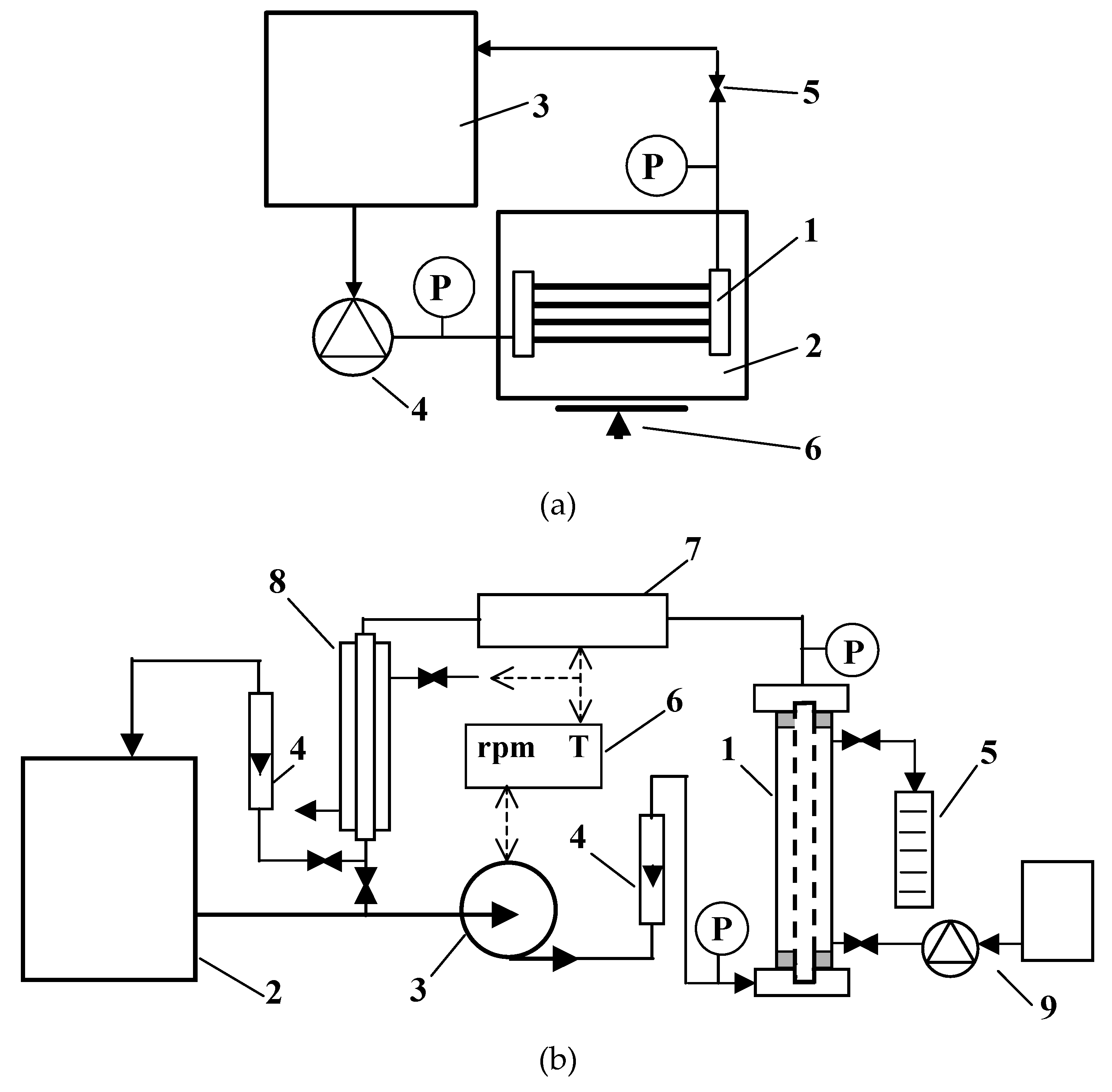

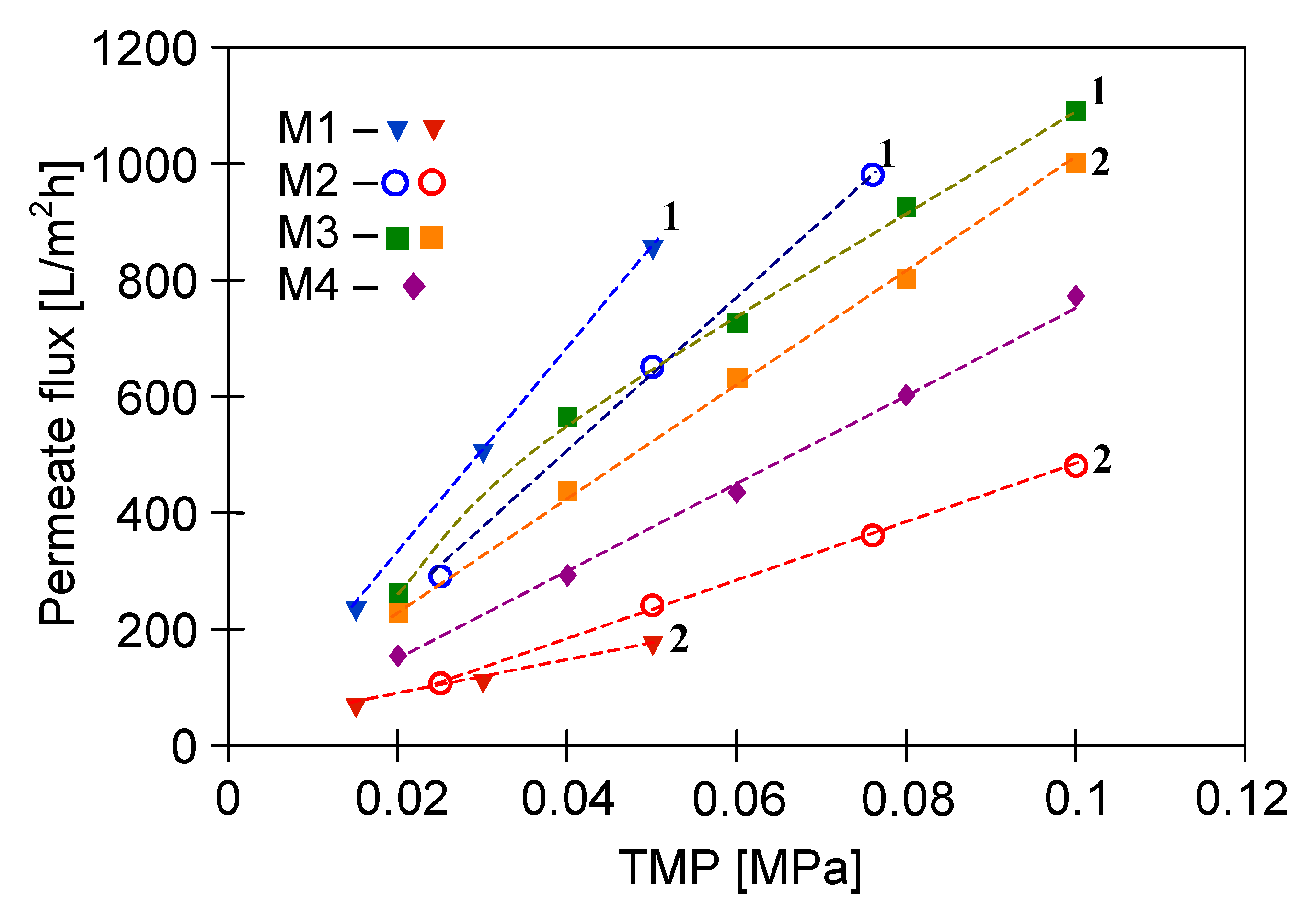
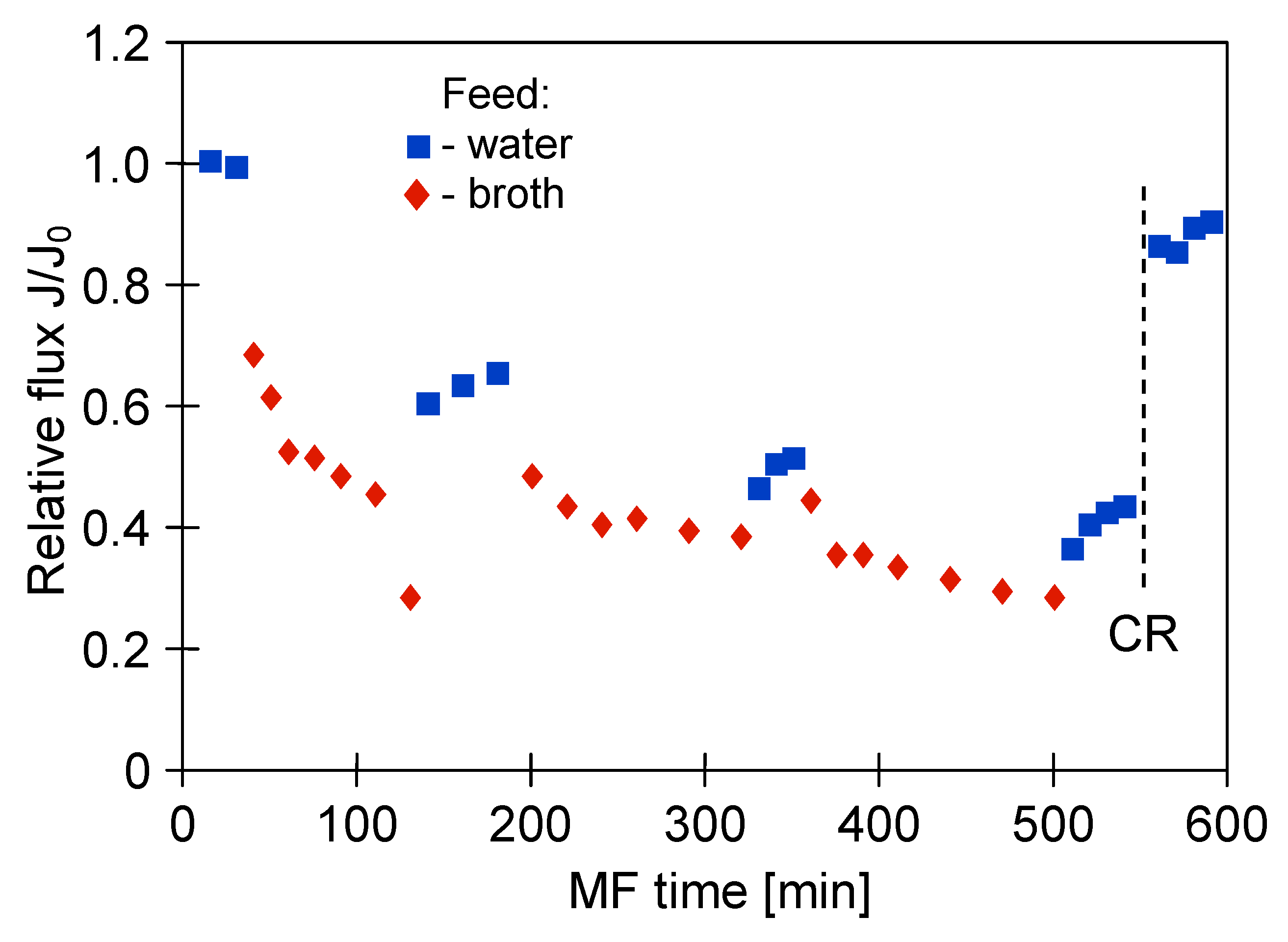

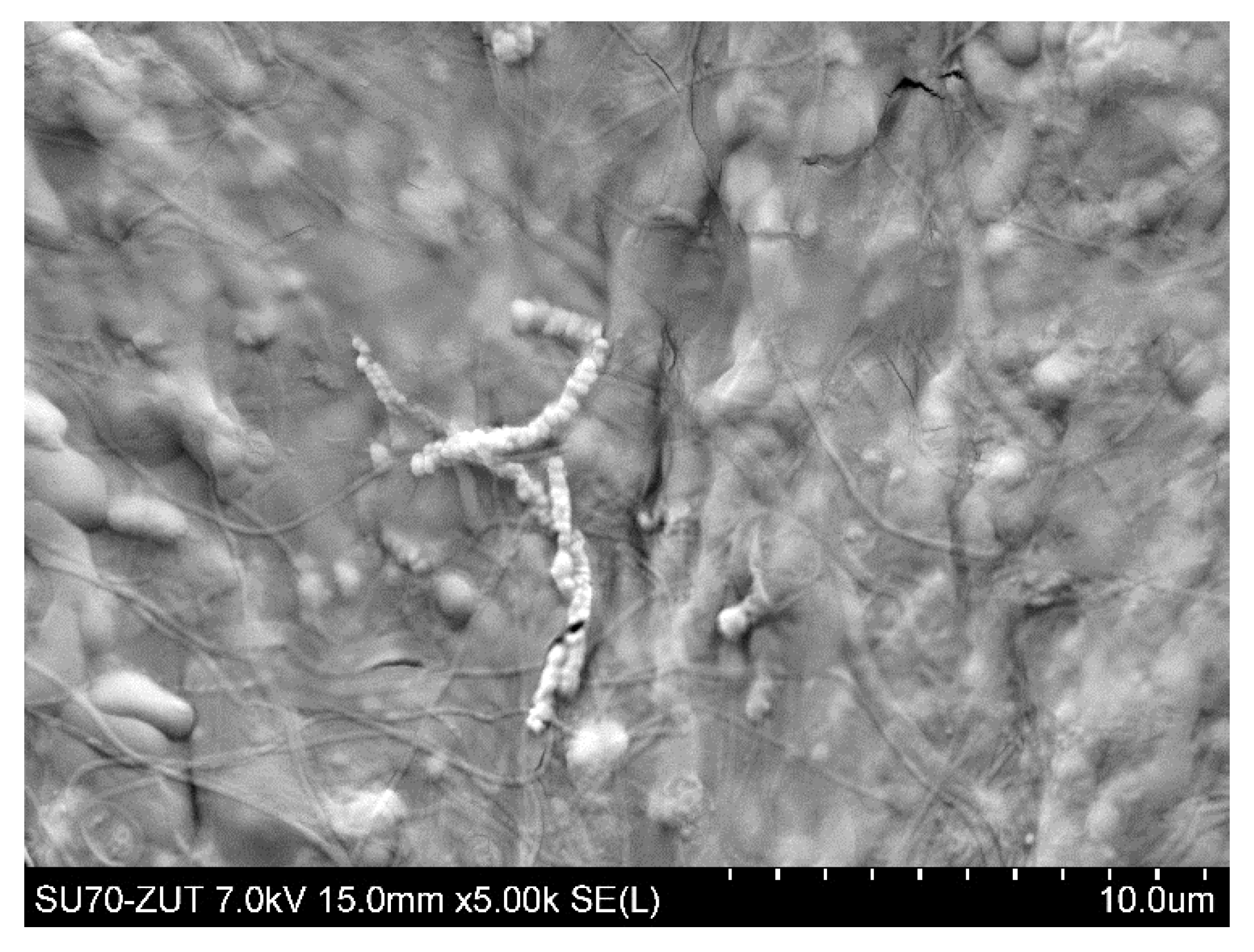
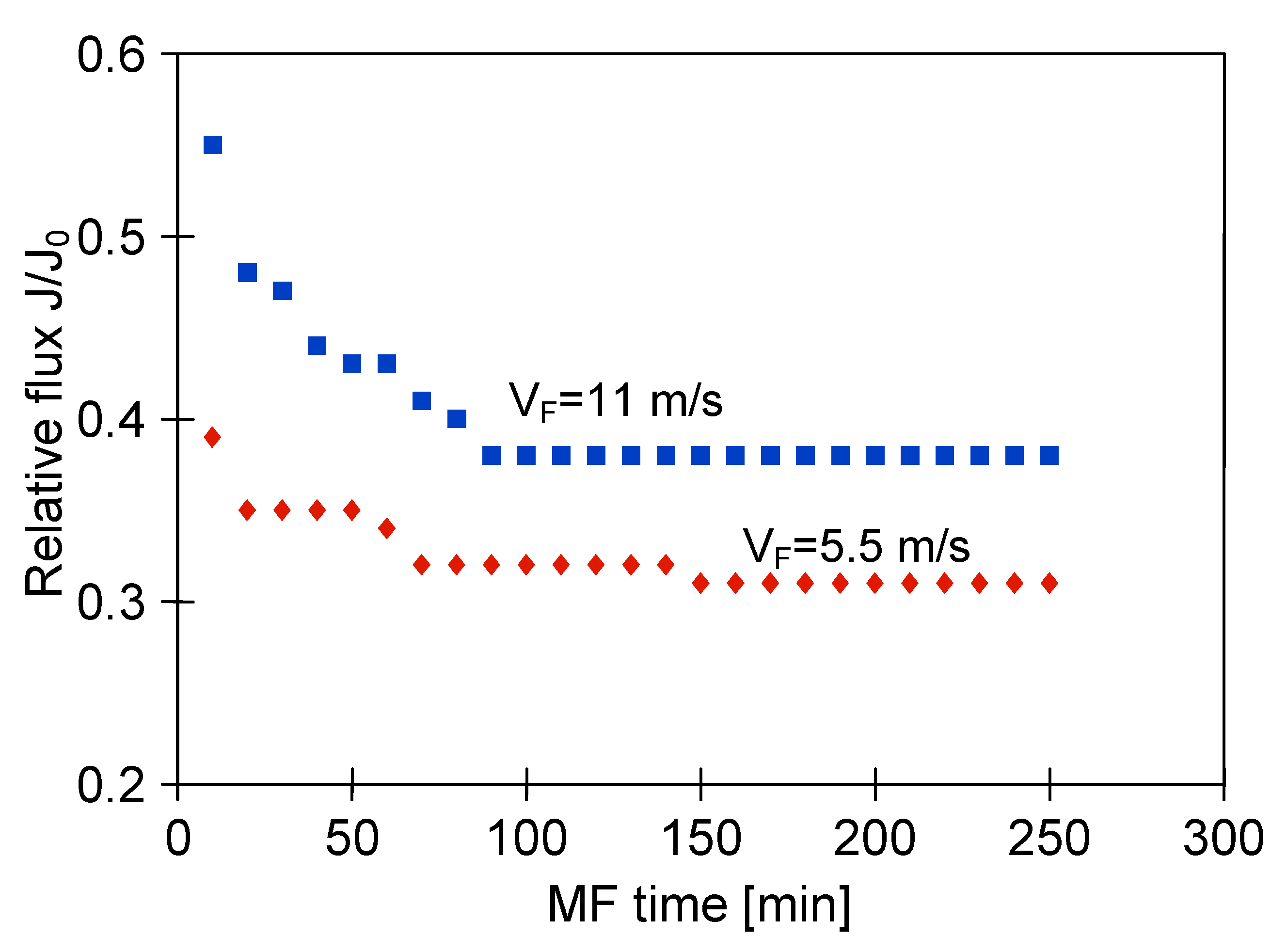

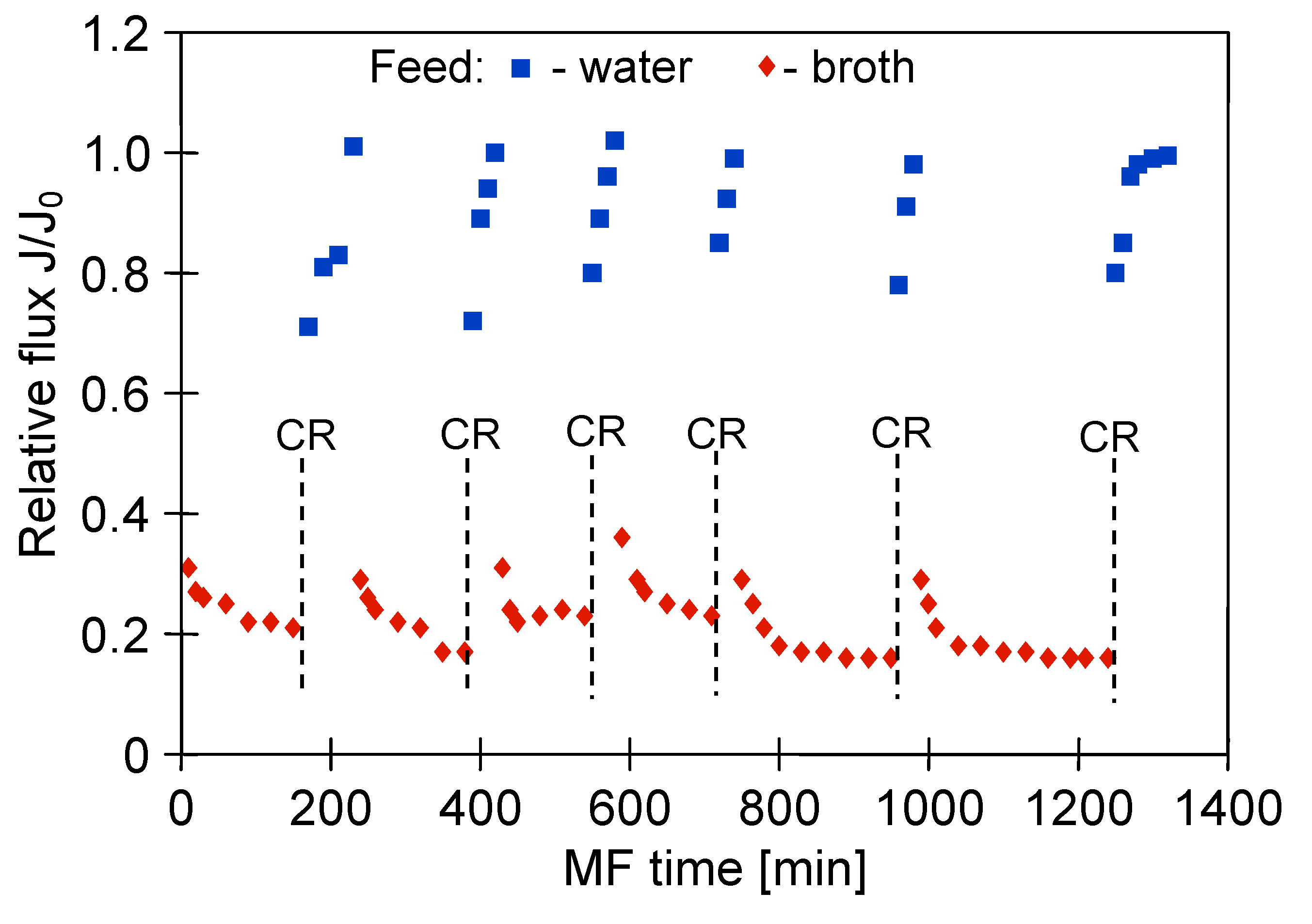
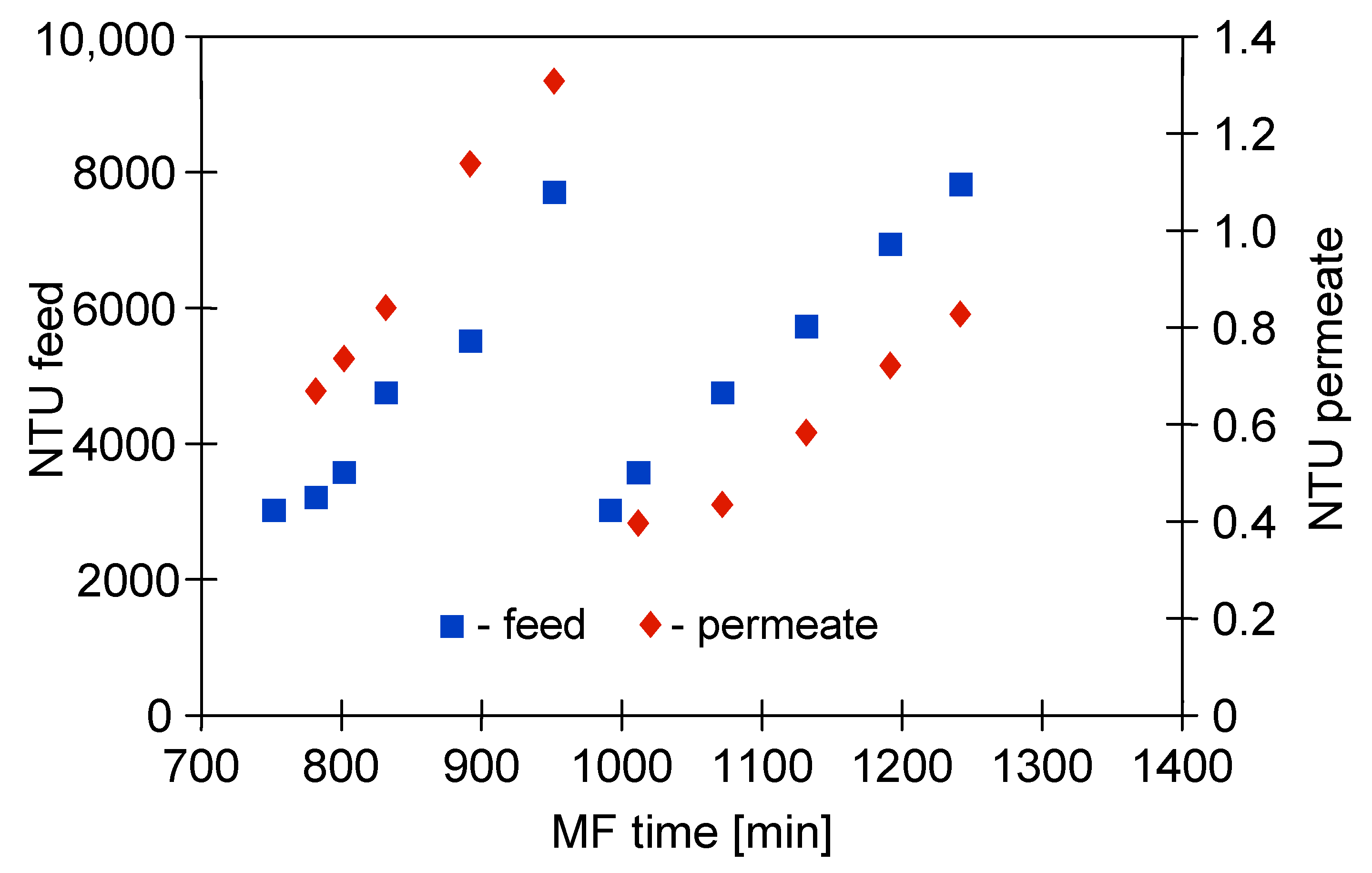
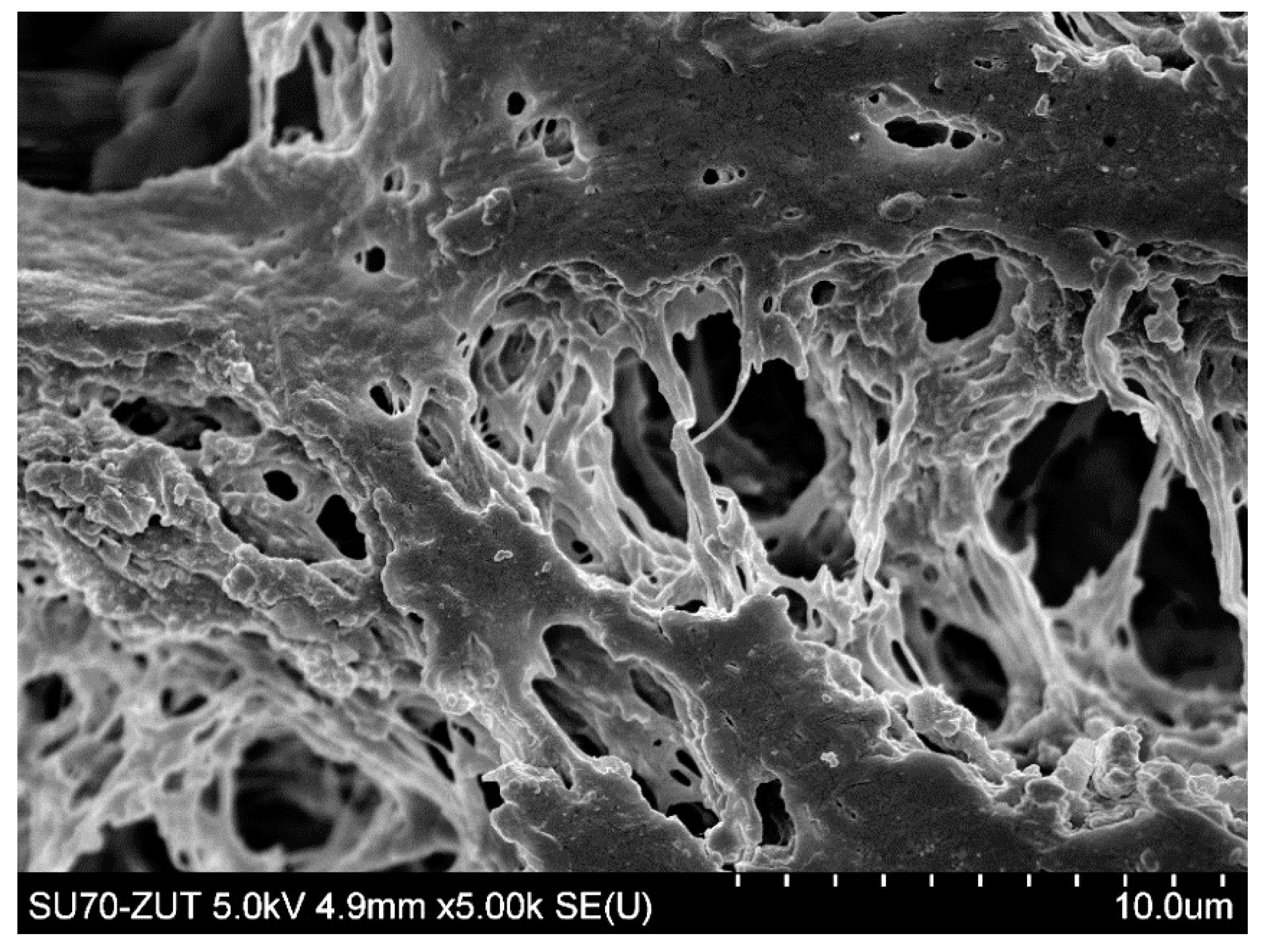

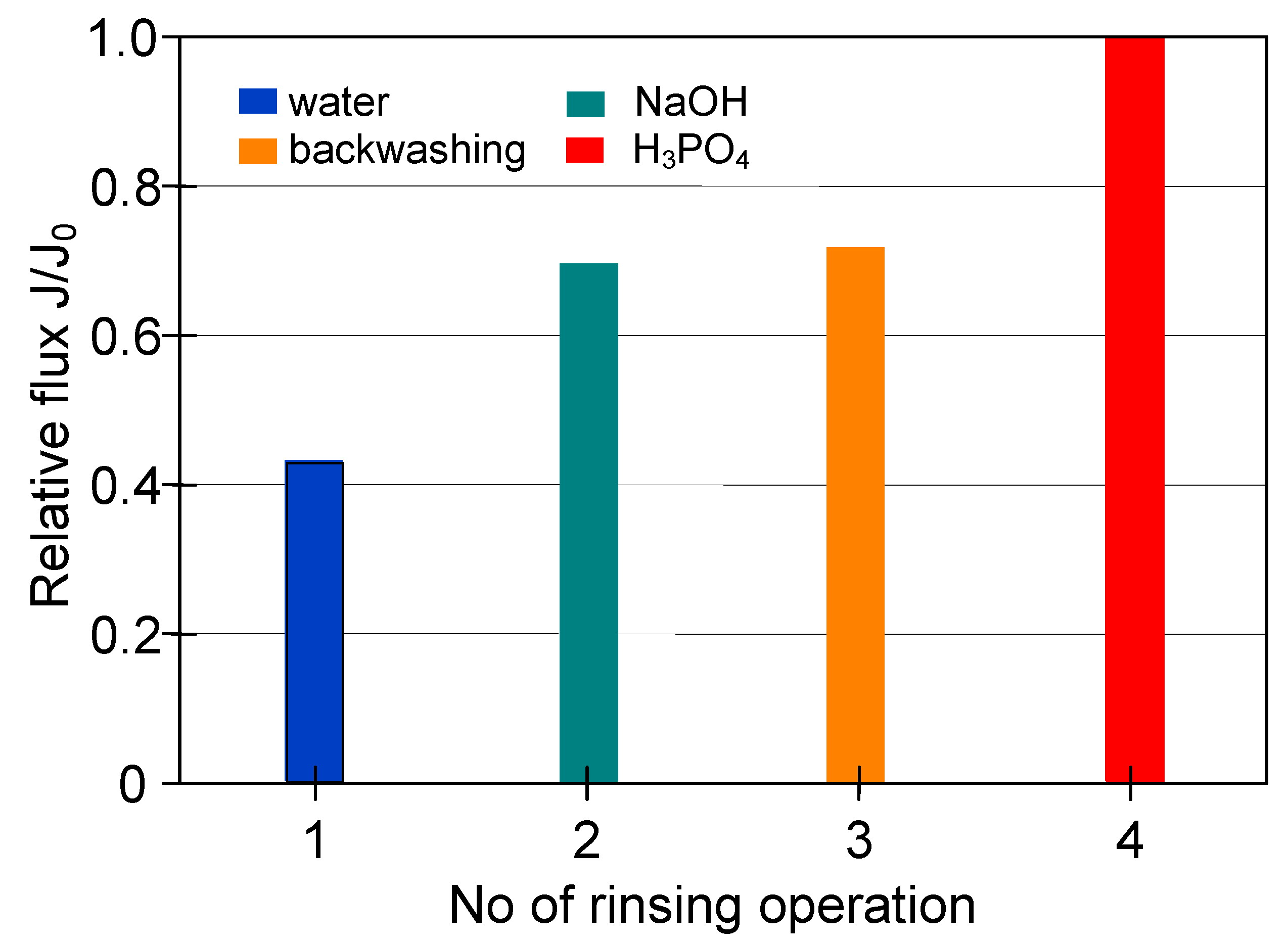
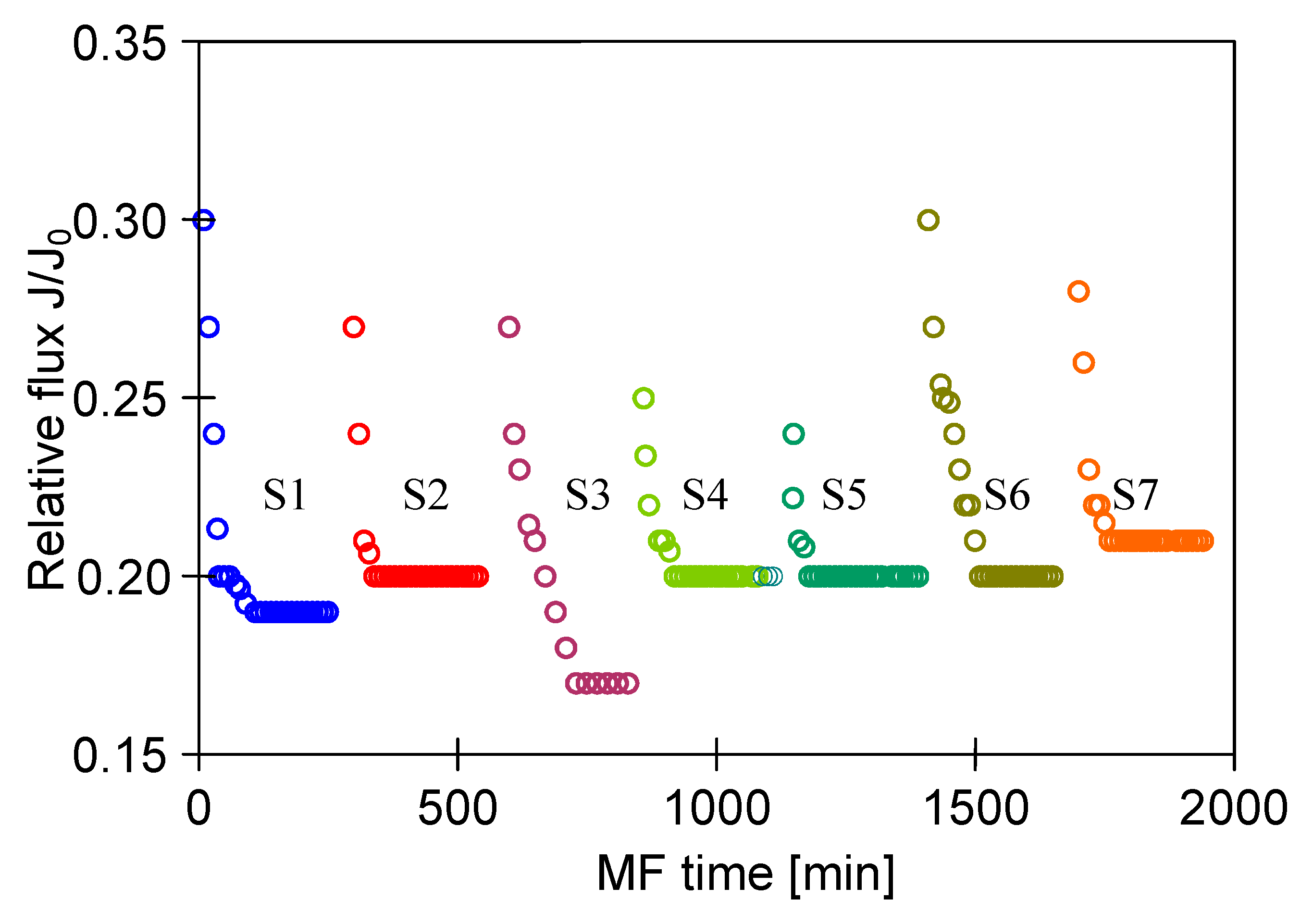
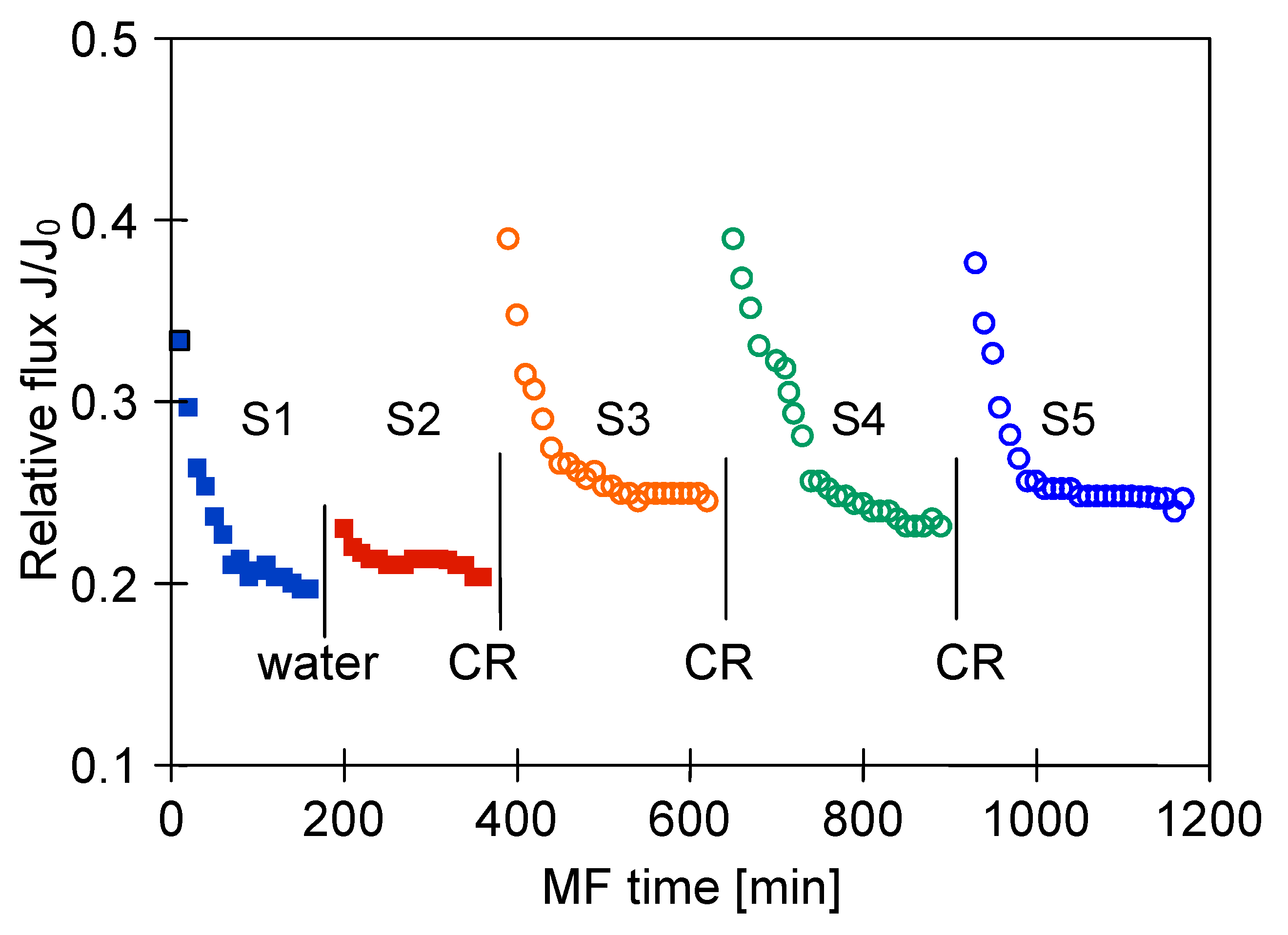



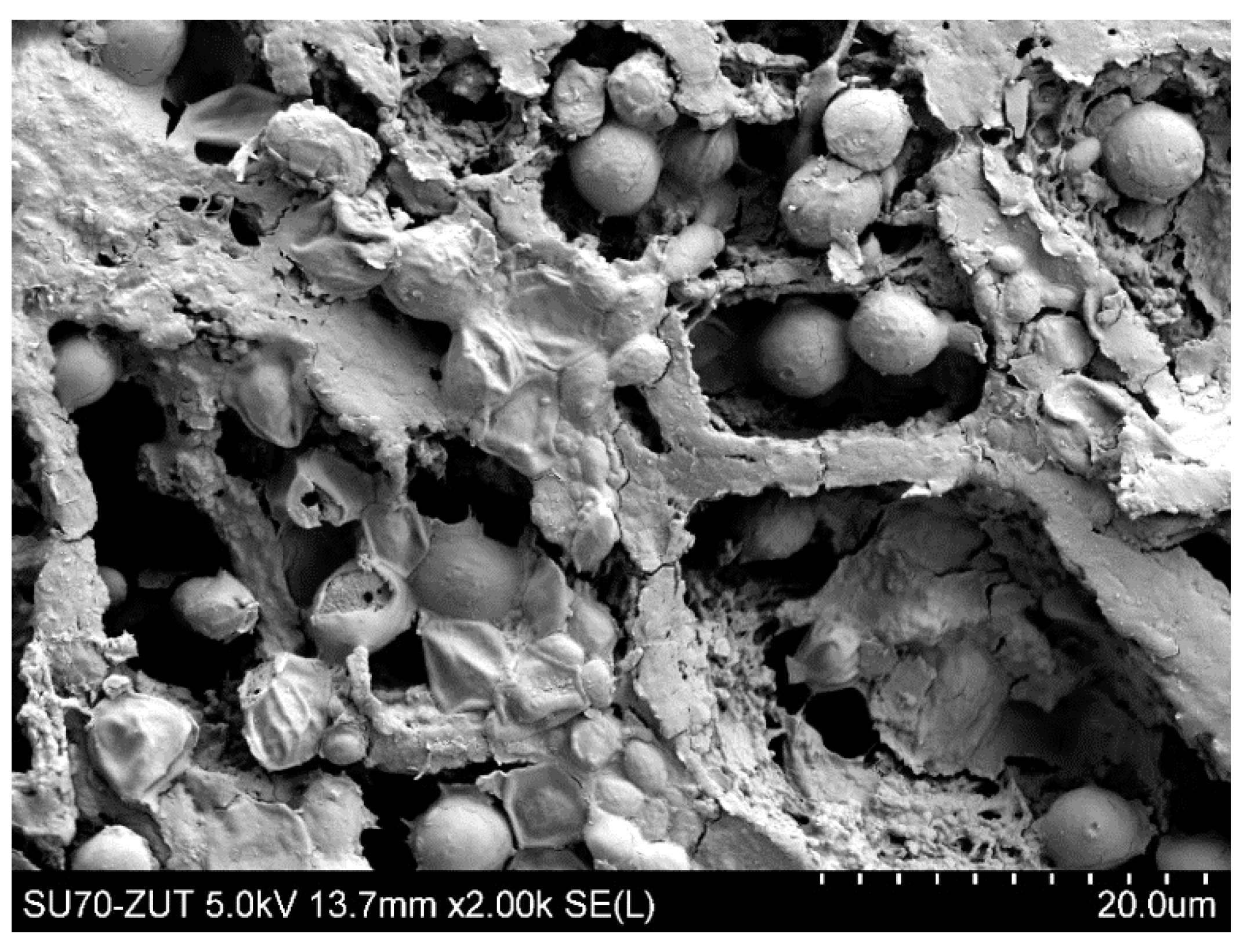
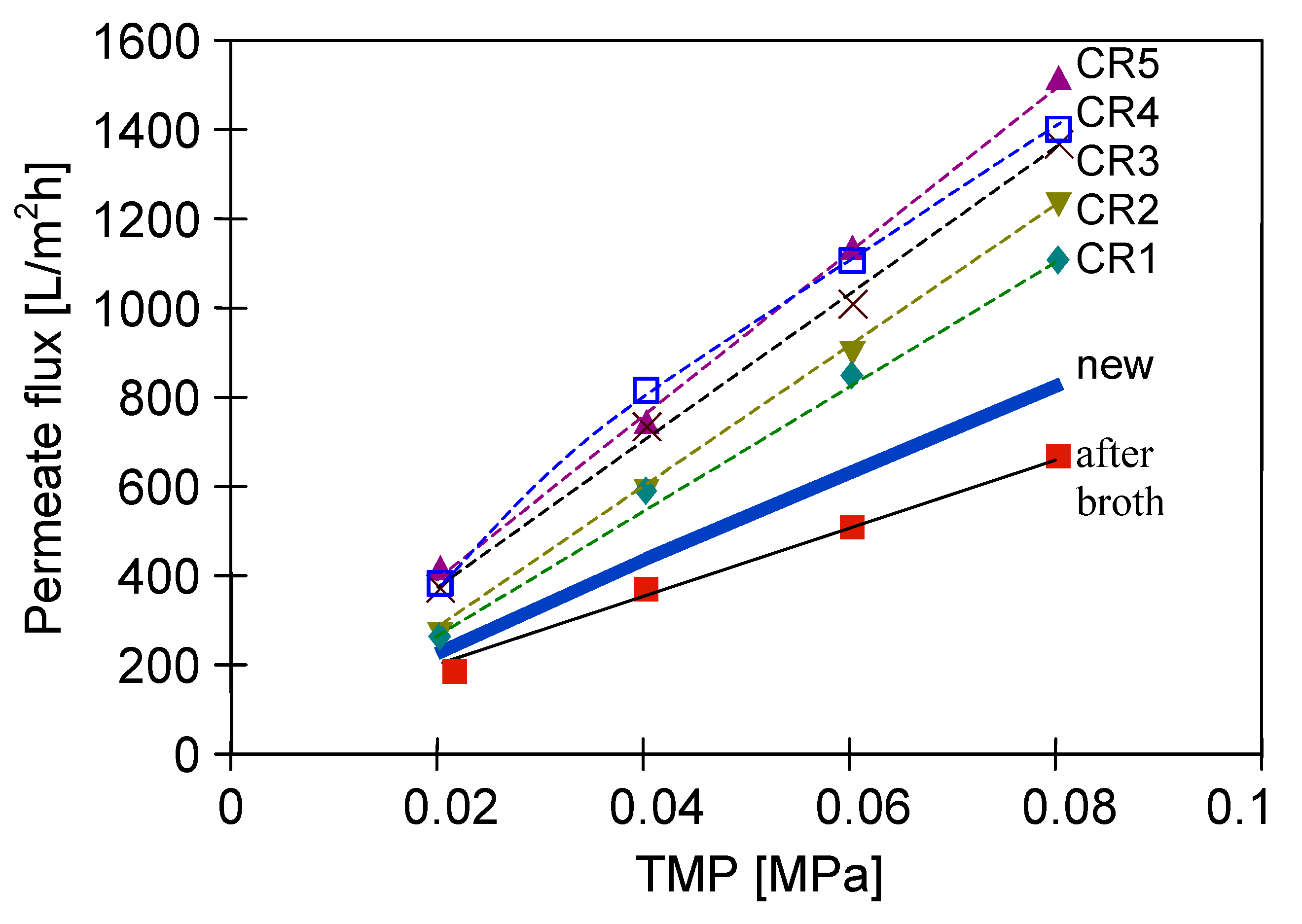
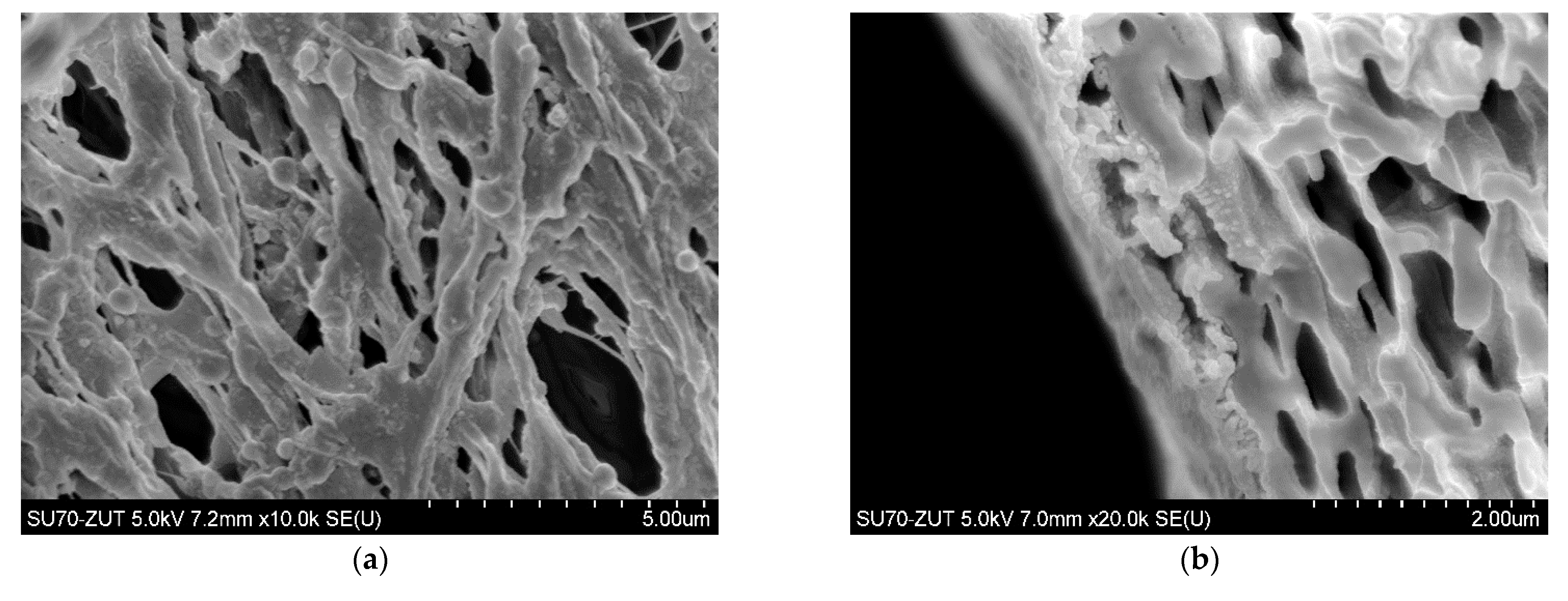



| Component [g/L] | Lactobacillus casei | Citrobacter freundii |
|---|---|---|
| wetted mass | 21.6–27.9 | 28–32.5 |
| meat extract | 8 | 1.5 |
| yeast extract | 5 | 2 |
| peptone K | 10 | 2.5 |
| lactic acid | 13.5–15.2 | 2.1–3.5 |
| 1,3-propanediol | - | 18.9–22.5 |
| glycerol | 3–4.7 | 1.7–3.8 |
| acetic acid | 2–3.6 | 1.2–2.3 |
| formic acid | 0.25–0.3 | 0.8–1.22 |
| succinic acid | - | 0.7–2.13 |
| amonium citrate | 2 | - |
| K2HPO4·3H2O | 0.6 | 3.4 |
| KH2PO4 | - | 1.3 |
| MgSO4·7H2O | 0.4 | 0.9 |
| (NH4)2SO4 | - | 2 |
| CH3COONa | 1.5 | - |
| CaCl2·2H2O | - | 0.01 |
| CoCl2·6H2O | 0.004 | 0.002 |
| Module | Manufacture | Membrane | d1 [µm] | D2 [mm] | Length [cm] | Wall [mm] | Area [cm2] |
|---|---|---|---|---|---|---|---|
| M1, M2 | Membrana GmbH, Germany | Accurel PP S6/2 | 0.20 | 1.8 | 95 | 0.4 | 21.5 |
| M3 | Membrana GmbH, Germany | Accurel PP V8/2 HF | 0.20 | 5.5 | 22 | 1.5 | 38.0 |
| M4 | Tami Ind., France | TiO2 | 0.14 | 5.6 | 22 | 2.0 | 38.7 |
Publisher’s Note: MDPI stays neutral with regard to jurisdictional claims in published maps and institutional affiliations. |
© 2021 by the authors. Licensee MDPI, Basel, Switzerland. This article is an open access article distributed under the terms and conditions of the Creative Commons Attribution (CC BY) license (http://creativecommons.org/licenses/by/4.0/).
Share and Cite
Tomczak, W.; Gryta, M. Comparison of Polypropylene and Ceramic Microfiltration Membranes Applied for Separation of 1,3-PD Fermentation Broths and Saccharomyces cerevisiae Yeast Suspensions. Membranes 2021, 11, 44. https://doi.org/10.3390/membranes11010044
Tomczak W, Gryta M. Comparison of Polypropylene and Ceramic Microfiltration Membranes Applied for Separation of 1,3-PD Fermentation Broths and Saccharomyces cerevisiae Yeast Suspensions. Membranes. 2021; 11(1):44. https://doi.org/10.3390/membranes11010044
Chicago/Turabian StyleTomczak, Wirginia, and Marek Gryta. 2021. "Comparison of Polypropylene and Ceramic Microfiltration Membranes Applied for Separation of 1,3-PD Fermentation Broths and Saccharomyces cerevisiae Yeast Suspensions" Membranes 11, no. 1: 44. https://doi.org/10.3390/membranes11010044
APA StyleTomczak, W., & Gryta, M. (2021). Comparison of Polypropylene and Ceramic Microfiltration Membranes Applied for Separation of 1,3-PD Fermentation Broths and Saccharomyces cerevisiae Yeast Suspensions. Membranes, 11(1), 44. https://doi.org/10.3390/membranes11010044






